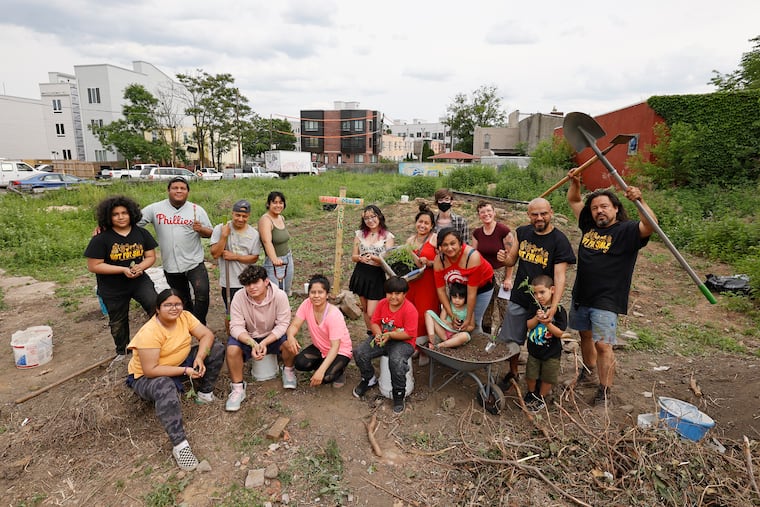Iglesias Garden becomes a safe space for residents seeking ‘sovereignty’ in North Philly
César Andreu Iglesias Community Garden has become the headquarters for the people’s resistance, where they gather to share concerns and unite against gentrification.

West Kensington continues to change and, along with it, the community’s green, vacant lots.
The North Philadelphia neighborhood — heavily affected by gentrification over the last decade — was active over the last year, despite the pandemic, as new construction continued and protests against development took place. It was the epicenter for rallies and celebrations around these projects, including after plans were abandoned to develop a high-rise apartment complex along American Street. The project was canceled because of pandemic concerns, community opposition, potential environmental contamination at the site, and a shift to allow the community more say in what will be built in the former industrial corridor.
Despite the win, activists and longtime residents continue to grapple with complicated legal processes and government bureaucracy in trying to keep their homes, yards, and gardens — many located on city-owned property — from being snatched by developers.
The César Andreu Iglesias Community Garden, at the corner of North Lawrence and Arlington Streets, has become the headquarters for the people’s resistance, where they have gathered since 2012 to share concerns about the use of neighborhood land and their experiences with developers, to fill out paperwork to protect properties, and to organize and unite.
Now, as COVID-19 cases plummet and the summer vibes arrive, residents from around the region, especially Mexican and Central Americans from South Philly, are using the César Andreu Iglesias Community Garden as an open, green space where they are able to reunite with nature, practice food sovereignty, and gather for traditional Latino customs.
In addition to serving as the home base for the barrio’s anti-gentrification movement, the 40 small lots that make up the garden and center are being used to host birthday celebrations, papier-mâché workshops for children, poetry writing classes, and Aztec dances during celestial calendar events. Residents from the city and the suburbs also visit the garden to cook barbacoa in a unique underground oven and to plant cempasúchil, sun flowers, moco de pavo, cilantro, tomatoes, chile, beans, and blue and yellow corn.
César Viveros, Mexican muralist and one of the garden’s education committee members, said the site has become a common ground for people of all religions and races, especially for Black and Latino children with no patios or yards in which to play.
“This could have been another pile of trash or a housing complex that no one in the community could pay for,” he said. “Instead, it’s a place where the grassroots, the 99%, can come together, enjoy without fears of judgment, and create the future they want for their kids.”
The garden, named after a Puerto Rican novelist, is also known as Little Tenochtitlán, an indigenous locality in what is now the historic center of Mexico City. Community members have organized a nonprofit entity called Iglesias Gardens Co., with subcommittees that work on making sustainable use of the land, educating around it, and trying to legally protect it from possible development.
It’s been cleaned and worked on during weekends since late last year by 45 community members and residents from as far as Aston and northern Delaware.
Herendira Zamacona, 35, from South Philadelphia, has been working on the corn crops since early April. Her father, a farmer in Mexico, taught her how to harvest when she was a teenager. Some 16 years later, she said the garden has given her the chance to touch soil again.
“Here, we have the freedom, the sovereignty, to express ourselves in all shapes and forms,” she said. “Here, we are not foreign anymore.”
Zamacona works alongside Mara Henao, Susana González, Rosa Ruíz, María Rosas, and their children to take out weeds, dig, and plant with no irrigation system. The barbacoa cooking ceremonies, with beef, lamb, and rabbit, start at 3 a.m. every other weekend. Most of the workshops and performances are held during community events, when residents in the predominantly Black and Puerto Rican West Kensington neighborhood can participate.
The community garden has been mostly funded by the people who use it. Organizers look forward to placing wooden fences around the lots and building a large sunflower sculpture to house a rainwater retention system.
Ivonne Pinto-García also works the land. After living in South Philly for over a decade, she said this garden has given her moments to “drown her sorrows” from the pandemic frustration.
“None of us know how much we needed this place until we got here, and I hope it serves as an example to replicate around the city, especially during these frustrating times.”
Even though the Philadelphia Land Bank has approved the deposition of its 20 properties to Iglesias Gardens Co. the site is still at risk.
Adam Butler, who has been working on the land security committee for Iglesias Garden Co. since 2018, said the nonprofit has about six more months of paperwork and procedures with City Council until they can claim formal ownership from the land bank.
Leslie Fuentes, a community organizer for the garden, said the plight has been long and frustrating for the longtime, non-English-speaking Puerto Rican residents in the area. Fuentes added it feels great to have an outdoor space where people from the community can enjoy the food and customs they like in a safe, collegial environment.
“You know, the land belongs to the ones who work it and, even though we are still battling for the land, it’s awesome that people of all backgrounds are coming together to protect this land — Indigenous land.”